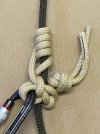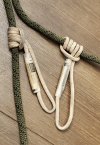CharlieTN
Well-Known Member
- Joined
- Sep 21, 2019
- Messages
- 580
Thought I would put together some information for many of the new saddle hunters out there. Often times they get stuck on the Prusik Knot as their friction hitch and then they become frustrated with it. There is also a misuse of that name. Much like Bandaid has become a generic name for an adhesive bandage, so Prusik has become the generic name for friction knots in general but that can be very misleading.
Here is the basic Prusik Knot. It works, in fact it often works too well tightening down so much that it can be difficult to adjust, especially one handed. One big advantage to the Prusik knot is that it is bi-directional. It will hold a pull from either direction. The biggest disadvantage is that it is hard to release once weight is taken off. The Prusik is most often made with a continuous (whether tied, or sewn) loop of cord.


My favorite, and one you will heart mentioned quite a bit is the Schwabisch Hitch. The biggest advantage to the Schwabisch is that it will release relatively easily once weight is taken off making it easier to move. Because of this you’ll see it used on adjustable bridges, tethers, and lineman’s ropes. There is a method to be able to make it with a continuous loop. I would have to look that up again as it’s been a couple of years. Normally it is tied with a length of rope with a loop on each end. The Schwabisch also works very well with a tender to enable one-handed adjustments. In my opinion, the only possible advantage the Prusik has over the Schwabisch is that the Schwabisch really only works properly in one direction unlike the Prusik which is bi-directional.


A close cousin to the Schwabisch Hitch is the Distel Hitch. In fact it looks very similar with the only major difference being that the running ends that go to the carabiner crisis cross in an x as they leave the knot unlike the Schwabisch where they run parallel to one another.. It works equally well in all of the situations where the Schwabisch works. My only reason for preferring the Schwabisch over the Distel Hitch is that the actual knot portion of the Distel Hitch tends to sort of stretch out on the rope as it has weight put on it and sometimes it will not release as easily as the Schwabisch, hence my preference for the former.


Here I wanted to show my favorite friction hitch when I have a loop of rope, and that is the Klemheist. It’s easy to tie in, can even be done one handed with some practice, is easy to make sure you have it tied correctly, and it works. The Klemheist releases easily when weight is taken off. That is really it’s only flaw, sometimes it doesn’t want to grab right away if your friction cord is stiff. But when it tightens up it holds well and will release easily when you need it to. In my opinion it makes a good backup/safety friction hitch.


And finally is the Blake’s Hitch. The big advantage that the Blake’s hitch has over the others is that it can be tied with a single run of rope. All of the others required being tied with a loop or at a minimum two free ends to hook into the carabiner. I did notice that it appears that CGM is using the Blake’s Hitch for their rope belt and it’s a great option. When tightened it holds very well although it does not release quite as easily as the other options.


Hopefully this will help you see that there are way more friction knots out there than the much promoted, and also much hated Prusik. This is definitely just a partial list as there are many, many more. Some that work better but are often much more complicated to tie or require a longer length of cord. If you’re interested in learning to tie any of these, simply google the name and you’ll find excellent instructions out on the web.
Stay safe.
Here is the basic Prusik Knot. It works, in fact it often works too well tightening down so much that it can be difficult to adjust, especially one handed. One big advantage to the Prusik knot is that it is bi-directional. It will hold a pull from either direction. The biggest disadvantage is that it is hard to release once weight is taken off. The Prusik is most often made with a continuous (whether tied, or sewn) loop of cord.


My favorite, and one you will heart mentioned quite a bit is the Schwabisch Hitch. The biggest advantage to the Schwabisch is that it will release relatively easily once weight is taken off making it easier to move. Because of this you’ll see it used on adjustable bridges, tethers, and lineman’s ropes. There is a method to be able to make it with a continuous loop. I would have to look that up again as it’s been a couple of years. Normally it is tied with a length of rope with a loop on each end. The Schwabisch also works very well with a tender to enable one-handed adjustments. In my opinion, the only possible advantage the Prusik has over the Schwabisch is that the Schwabisch really only works properly in one direction unlike the Prusik which is bi-directional.


A close cousin to the Schwabisch Hitch is the Distel Hitch. In fact it looks very similar with the only major difference being that the running ends that go to the carabiner crisis cross in an x as they leave the knot unlike the Schwabisch where they run parallel to one another.. It works equally well in all of the situations where the Schwabisch works. My only reason for preferring the Schwabisch over the Distel Hitch is that the actual knot portion of the Distel Hitch tends to sort of stretch out on the rope as it has weight put on it and sometimes it will not release as easily as the Schwabisch, hence my preference for the former.


Here I wanted to show my favorite friction hitch when I have a loop of rope, and that is the Klemheist. It’s easy to tie in, can even be done one handed with some practice, is easy to make sure you have it tied correctly, and it works. The Klemheist releases easily when weight is taken off. That is really it’s only flaw, sometimes it doesn’t want to grab right away if your friction cord is stiff. But when it tightens up it holds well and will release easily when you need it to. In my opinion it makes a good backup/safety friction hitch.


And finally is the Blake’s Hitch. The big advantage that the Blake’s hitch has over the others is that it can be tied with a single run of rope. All of the others required being tied with a loop or at a minimum two free ends to hook into the carabiner. I did notice that it appears that CGM is using the Blake’s Hitch for their rope belt and it’s a great option. When tightened it holds very well although it does not release quite as easily as the other options.


Hopefully this will help you see that there are way more friction knots out there than the much promoted, and also much hated Prusik. This is definitely just a partial list as there are many, many more. Some that work better but are often much more complicated to tie or require a longer length of cord. If you’re interested in learning to tie any of these, simply google the name and you’ll find excellent instructions out on the web.
Stay safe.



